Learn how to feed and maintain a successful sourdough starter in 3 easy steps! Tips shared for choosing the best flour, the right jar, and how to keep it alive (without the stress).
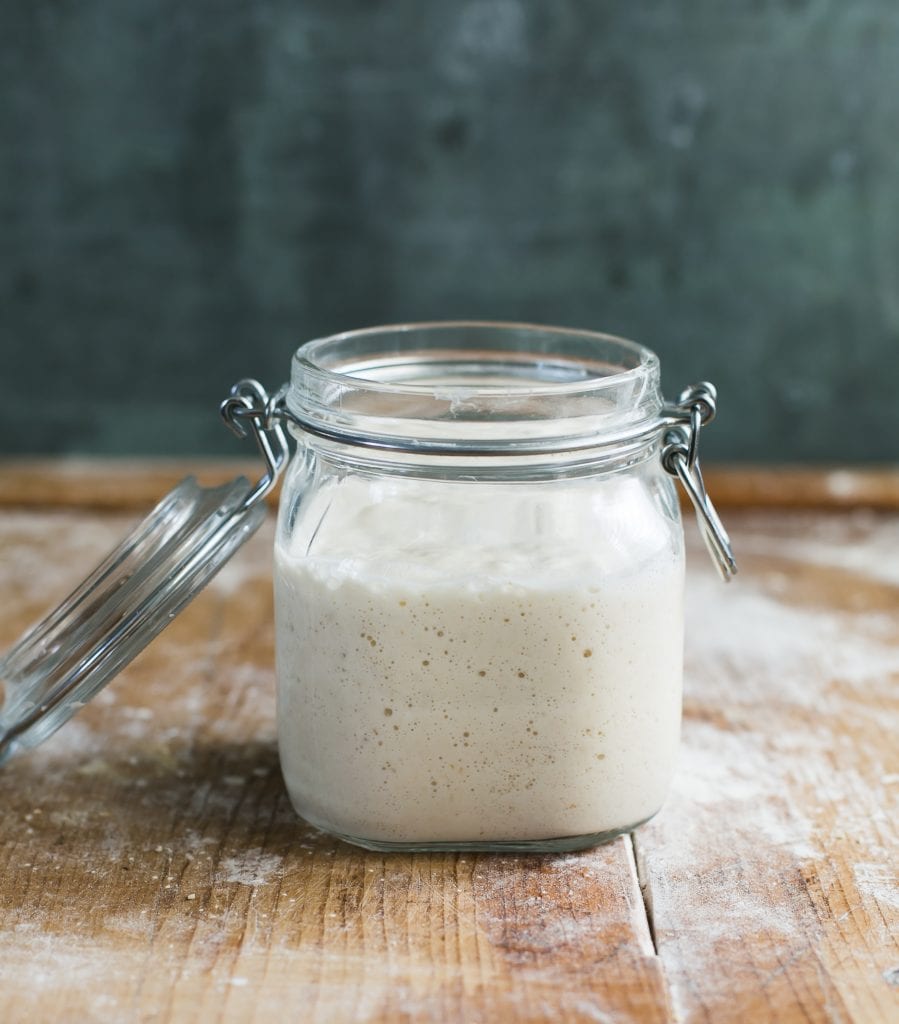
Without fail, the most intimidating aspect of sourdough bread recipes is understanding how to feed and maintain your sourdough starter. If you don’t have a healthy starter, you can’t make sourdough bread, sourdough focaccia or anything else with a lofty-high rise! I discuss this in detail in my bestselling book Artisan Sourdough Made Simple. However, I’ve written a quick guide below so you can tackle this right away.
In this post, you’ll find sourdough starter feeding instructions (at a glance) and (in depth) depending on how much instruction you need. I’ve also included tips on how to store & maintain your sourdough starter with helpful FAQs at the end.
But First: What is Sourdough Starter?
Simply put: a sourdough starter is a live fermented culture of flour and water. Once it’s fed with additional flour and water (and left in a warm spot to rise, ideally 75+ F), it becomes bubbly and active. A small portion of this active starter is used to make bread dough rise. Instant yeast is not required.
Why Feeding Matters
Most bakers, especially beginners, don’t realize that you can’t just create a sourdough starter, leave it on the counter and expect it to work on a moment’s notice. You’ll need to feed it every time prior to making bread dough. This is referred to as “activating” your starter. Then, to keep it alive, you’ll need to maintain it with regular ongoing feedings to keep it strong.
Feeding Sourdough Starter (You Will Need):
- Sourdough Starter
- Jar with lid (I use this one)
- Kitchen Scale
- Bread flour or all purpose
- Water, filtered or quality tap water (that doesn’t taste like chlorine).
Looking for a starter? Try my Beginner Sourdough Starter Recipe with step-by-step instructions.
What is the Sourdough Starter Feeding Ratio?
Because we all have different quantities of sourdough starter, bakers feed their starters by ratio. The most common feeding ratio is 1:1:1 (sourdough starter: flour: water). This is also known as a 100% hydration starter.
For example, let’s say you have 40 g of sourdough starter in a jar. To feed it, you’ll add 40 g of flour + 40 g of water. This is referred to feeding with “equal parts by weight.” You need a scale for this (measuring cups are not considered “equal parts by weight” because different ingredients weigh different amounts). You should also know, this feeding ratio applies to any quantity of starter. If you have 20 g starter in a jar, feed it with 20 g flour + 20 g water. You can scale the ratio up or down.
TIP: Texture is key. While following a feeding ratio is helpful, use it as a guide only. It doesn’t have to be exact. Why? Because your starter will look different on different days. And because of that, it will need different things. This is due to the type/brand of flour used, temperature and the amount of time that has elapsed in between feedings. So, if you’ve followed the feeding ratio and your starter is too thick, add more water to thin it out. If it’s too thin, add more flour. The texture should look like thick pancake batter.
How To Feed Your Sourdough Starter (at a Glance)
- Remove and discard half of your sourdough starter
- Feed what’s left in the jar with equal parts flour and water by weight (1:1:1 feeding ratio).
- Let rise at room temperature (covered or airtight) ideally 75+ F, until bubbly, active and double in size (2-12 hrs.).
*Note: Before you begin, establish a regular feeding time. Morning or evening; the time itself doesn’t matter. What does matter is consistency. Feeding your starter at roughly the same time each day will train it to rise and fall predictably. This way, you’ll know when it’s ready to use. For example, if you want to make dough at 7 PM (and your starter takes about 5 hrs to rise), feed it at 2 PM.
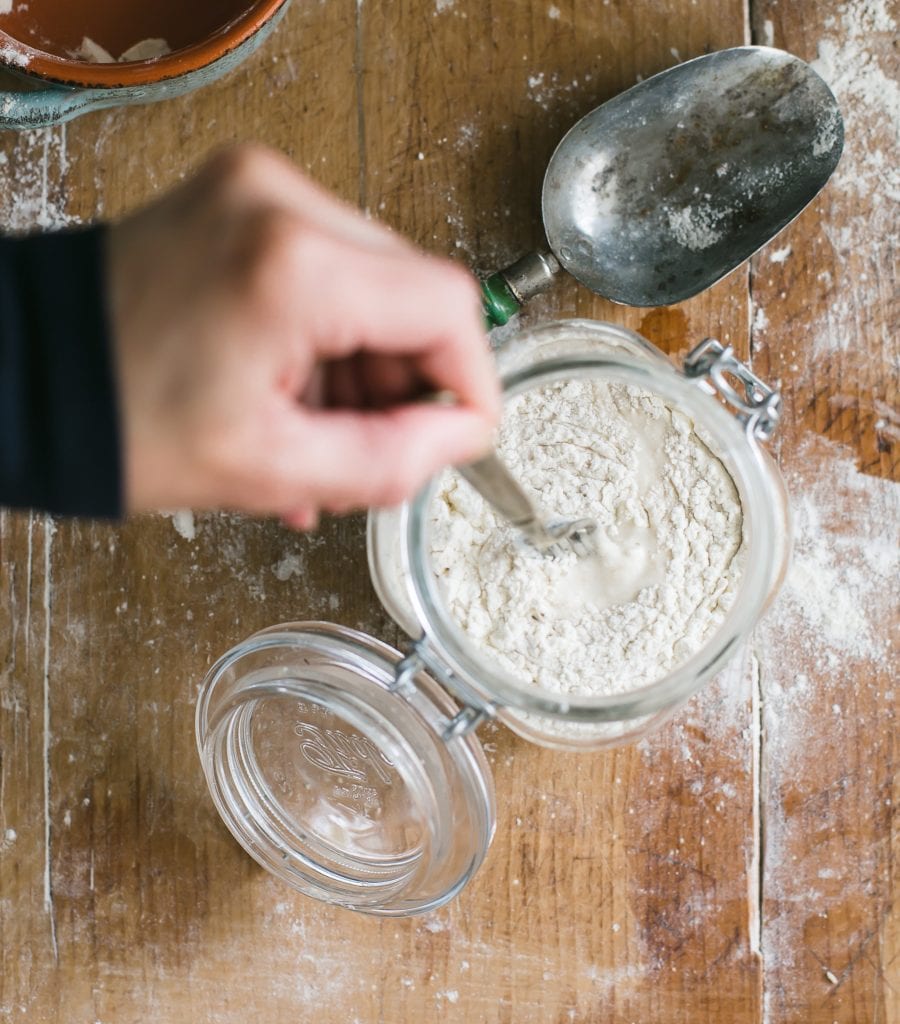
Feeding Sourdough Starter (In-Depth)
- Remove and Discard. Let’s say you have about 120 g of sourdough starter. The first step is to remove half, about 60 g, into a separate bowl (use a spoon or pour it out). What’s leftover in the bowl- the amount you just removed- is called sourdough discard. The discard can be used to make sourdough discard recipes such as my fluffy sourdough pancakes. Or, if discolored and smelly, you can just throw it out (we’ll talk more about this later).
- Feed the Starter. Now, you’re going to feed what’s left in the jar with equal parts flour & water by weight. I follow the sourdough feeding ratio of 1:1:1 (sourdough starter: flour: water). So, let’s continue with our example: You had 120 g of starter and removed half. You now have 60 g of sourdough starter in the jar. Feed it with 60 g flour + 60 g of water. Mix well with a fork, scraping down the sides as needed until the texture turns into a thick, lump-free batter. Place the lid on top.
- Let Rise Until Bubbly, Active & Double in Size (2-12 hrs.) Place your starter in a warm spot to rise and activate, ideally 75-80 F. Temperature is really important. The warmer it is, the faster it will rise. Your starter is active when it shows the following signs: doubles in size, small and large bubbles appear, has a spongey or fluffy texture and exhibits a pleasant aroma.
TIP: What goes up must come down. An active sourdough starter, one that has doubled in size, will eventually fall back down. This is normal. There’s nothing wrong with your starter when it falls; it’s just losing its strength as it goes down. It will only stay fully risen for 1-2 hours (this varies). Use it to make bread dough at peak height.
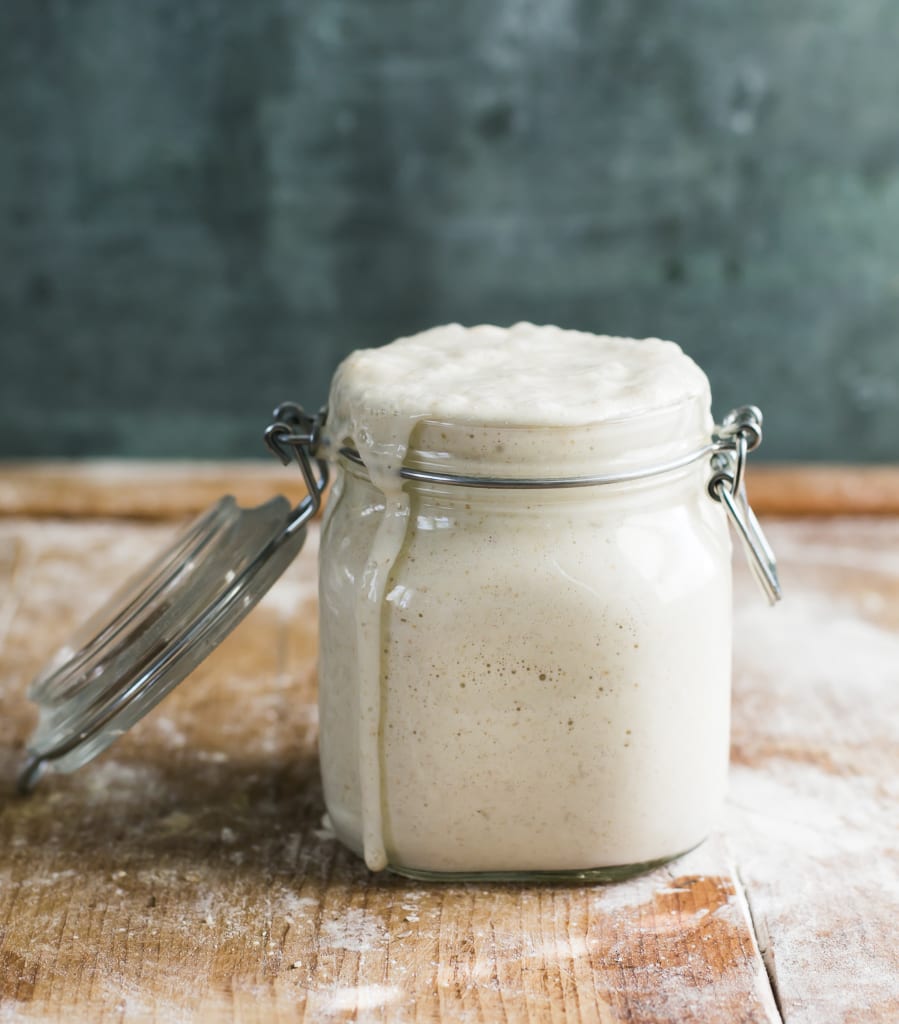
How to Store Sourdough Starter
Once you have a starter, you’ll need to maintain it with regular feedings when not in use- otherwise your bread won’t rise. Your feeding maintenance routine is directly related to where it’s stored and how often you plan to bake.
- Room Temperature: if you bake a few times a week, keep your starter at room temperature. You’ll need to feed it (1x) per day, even when not in use. Storing at room temperature, especially if it’s warm, will make it ready to use faster.
- In the Fridge: if you bake only once a week or once a month, store your starter in the fridge. Feed it (1x) per week to maintain it’s strength. You do not need to bring it to room temperature first before feeding it; just remove it from the fridge, feed it and put it back. When ready to use, feed the cold starter at room temperature until it perks back up. Use warm water. Find a warm spot. Remember, the warmer it is, the faster it will rise.
Feeding Sourdough Starter FAQs
Q: Why do we remove and discard sourdough starter?
This is the #1 question asked about the feeding process. While it might feel wasteful, it’s done to refresh the acidity levels and to control the starter’s growth in size. I recommend removing half as a guideline, but the exact quantity is not set in stone. Some days you’ll remove more or less, depending on what the starter looks like. If you do not discard (and yes, some bakers choose to do this), your starter would grow exponentially making it difficult to maintain. But remember! You don’t have to throw the discard away.
Q: What should I do with sourdough discard?
Make sourdough discard recipes. Additionally, you can save discard in the fridge, freeze it, share it, or create a new starter.
- Best Sourdough Pancakes
- Crispy Sourdough Waffles
- Overnight Sourdough Apple Cake
- Moist Sourdough Blueberry Muffins
- Ultimate Sourdough Banana Bread
- Secret Ingredient Sourdough Cornbread
Q: What if I don’t have a scale? Can I use measuring cups to feed my starter?
Yes, absolutely. However, “equal parts by weight” does not translate into measuring cups. Why? Because 1/4 cup flour does not weigh the same as 1/4 water. You can certainly use “equal measurements” if you’d like, but the texture will most likely be off. Adjust with more/less flour and water to achieve a thick, batter-like consistency.
Q: Do I need to feed and activate my starter every time before using it?
Yes. You cannot bake with inactive starter. To activate your starter, feed it with fresh flour and water, and then wait for it to bubble and double in size. Feeding a starter is not a once off activation process (like a new cell phone).
Q: What if I forget to feed my starter?
Totally normal. We all forget at some point. It’s not dead (and you didn’t ruin it). Please keep feeding it until it becomes bubbly and active. For best results, find a warm spot and use warm water for a boost. Starters are more resilient than you’d think- they just need time and patience.
Q: What’s the best flour for feeding sourdough starter?
Starters like routine. In my experience, it’s best to feed your main jar of starter with the same flour it’s made of.
For white flour starters, use unbleached all purpose flour or bread flour. These flours are inexpensive, easy to find, and reliable for starter growth. For whole wheat starters, use whole wheat flour. For rye starters, use rye flour etc.
For variety, some bakers prefer to use a 50/50 blend of whole wheat and white flour for an enzyme boost (starters love enzymes). This is fine too. See what works best for your taste, your budget and your convenience level.
Just do me one favor: when choosing flour, always consider how the starter will be used.
For example, a 100 % whole wheat starter might not work for Soft Sourdough Cinnamon Rolls because the unsifted bran will make the dough more hearty, rather than light and airy. On the flip side, it might be more desirable for Light Whole Wheat Sourdough to really amplify the nutty, wholegrain taste.
Q: What’s the best jar or container for sourdough starter? Does it need to be airtight?
Currently, I use a 3/4 L glass jar with a latch top. I love it. I prefer glass over plastic, it’s easy to clean and it doesn’t absorb any weird smells or chemicals.
Oftentimes, I switch things up and use jam jars, glasses and/or whatever else is clean! My friend Jim recently sent me this sourdough starter jar to try- it’s really cool. Whatever you choose, make sure the jar is large enough to accommodate the starter’s growth when it doubles in size- this is key.
Regarding the lid: it can be airtight or loosely covered. It depends on the baker. For example, when I want my starter to bubble up fast, I keep it airtight. But if the jar is not large enough for the starter to grow, it might burst through the lid. Always keep an eye on it. Alternatively, rest the lid on top of the jar without securing it. This way, the jar is technically still covered but it won’t break as the starter rises.
Q: How long will it take for my starter to rise?
The activation process is not instant. Plan on 2-12 hrs. depending on temperature and the strength of your starter. The warmer it is, the faster it will rise.
Q: Can you recommend a warm spot for my starter to rise?
Potential warm spots include a proofing box, a microwave with the light on, or inside the oven (turned off) with the light on for 1-2 hours but not overnight- the environment will become too warm. You can also try a warm water bath, with frequent water changes to maintain temperature.
Q: What is hooch?
At some point, you’ll experience a dark, grayish liquid on the surface of your sourdough starter. Don’t stress. Hooch is just a sign that your starter needs to be fed. Simply pour it off, removing any discolored starter underneath and give it a fresh feeding. The image below features two different starters I keep in the fridge: Country Starter (fed with 50/50 white flour + whole wheat) and my Basic Starter (all white flour) both with a layer of hooch on the surface.
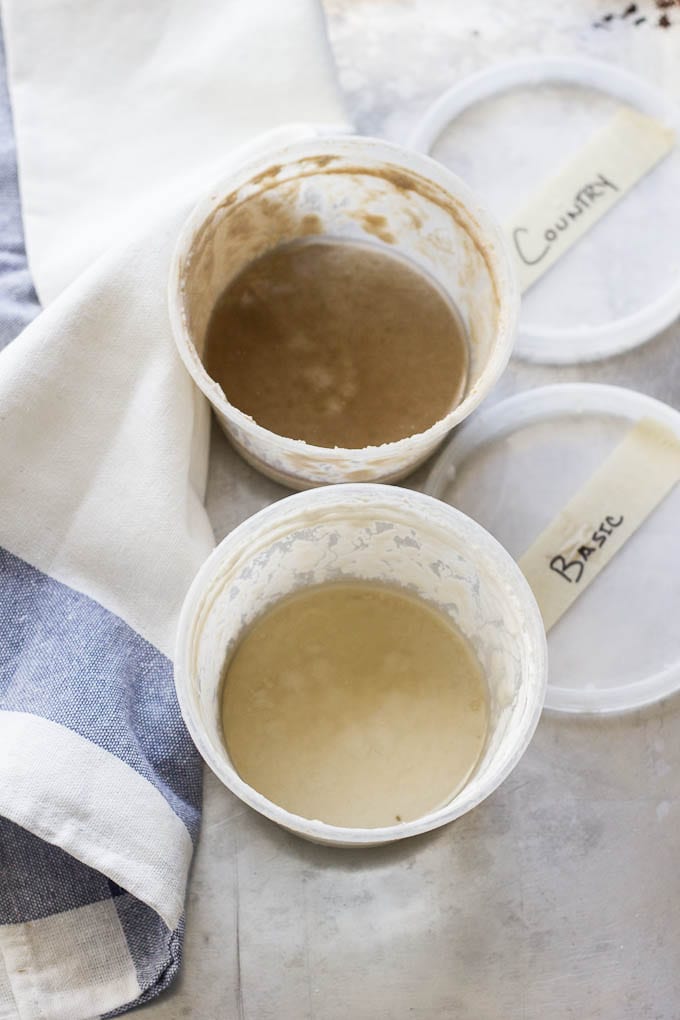
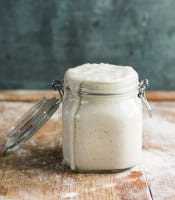
Feeding Sourdough Starter: My Best Tips & Tricks
- Prep Time: 5 hours
- Total Time: 5 hours
- Yield: 1 cup
- Category: Sourdough Starters
- Method: No-Cook
- Cuisine: American
- Diet: Vegetarian
Description
Learn how to feed and maintain a successful sourdough starter in 3 easy steps! Tips shared for choosing the best flour, the right jar, and how to keep it alive (without the stress).
Ingredients
- Sourdough Starter
- Jar with lid (I use this one)
- Digital Kitchen Scale
- Bread flour or all purpose
- Water, filtered or regular quality tap water
Instructions
*Note: Before you begin, establish a regular feeding time. Morning or evening; the time itself doesn’t matter. What does matter is consistency. Feeding your starter at roughly the same time each day will train it to rise and fall predictably. This way, you’ll know when it’s ready to use. For example, if you want to make dough at 7 PM (and your starter takes about 5 hrs to rise), feed it at 2 PM.
- Remove and discard half of your sourdough starter from the jar.
- Feed what’s left in the jar with equal parts flour and water by weight (1:1:1 feeding ratio). You need a digital kitchen scale for this. Because we all work with different quantities of starters, this 1:1:1 feeding ratio is best understood by example. So, if you have 60 g of starter in the jar, feed it with 60 g flour + 60 g water. If you have 30 g of starter, feed it with 30 g of flour and 30 g of water. Mix well with a fork, scraping down the sides as needed. Cover the jar with a lid. The lid can be airtight or loosely placed on top- your choice. Note: if the jar is airtight, the pressure will build up fast. Keep an eye on the jar so it doesn’t burst.
- Let your starter rise at room temperature, ideally 75+ F (the warmer it is, the faster it will rise), until bubbly, active and double in size (2-12 hrs). When your starter is at peak height, it’s ready to use. Eventually it will fall back down, and become inactive again. Then, you’ll need to repeat the feeding process.


Comments
Dinny Bedard says
Hi Emilie, I truly enjoyed your site and recipes! The Crinkle -top Sourdough Brownies” are the best and fudgest brownie I ever had! Not kidding!
Need your help with starting a whole wheat starter. Can I use my white bread flour starter to start a whole wheat starter? Should I use the same 1:1:1 ratio? Would you recommend 1/2 WW and 1/2 BF or can I use 100% WW? Thanks!
Dinny
Emma says
Wow this really worked. Thanks so much! I will definitely try this again!
Heidi says
Hello Emilie, I’ve really enjoyed learning from your site – thank you!
I don’t know why, but I’m really struggling to have my starter double – I use filtered water that I make sure is 80 – 85 degrees. I use KA unbleached white flour and 1/4 portion of KA wheat unbleached flour and make sure I have the 1:1:1 ratio. My starter is like pancake mix batter; sometimes I have to add a little extra water. It will grow a little bit and usually passes the float test but it has never doubled. I’ve been working on this starter for a few weeks now, and my one loaf that I baked today came out of my Christmas gift Dutch oven only 3 inches tall.
I’m happy for any help!
Meagan Castor says
I love your recipes and have totally felt successful with sourdough since someone directed me to your sight! I’m so thankful!
Question: I’m wanting to double my starter but I don’t want to wait until it falls after the first feeding simply because of time…can I feed it, let it double in size and then just feed it again or do I need to wait longer? Thanks in advance.
Bri says
I have a couple clarifying questions- Is discard the dormant stuff or the stuff before feeding? And every time you feed are you discarding half? Even if you store it in the fridge and are only feeding once a week? Thank you!
Pam says
Why won’t my starter double and bubble ? I use KA flour, a digital scale, follow your guidelines, and I am on day 7. I pour off the liquid, measure out 60g. A add to that 60 g of fresh KA flour and 60g warm water. Stir it well with a fork, no lumps. Put it in a clean container [i’m using a glass jar similar to the one you suggest] close the lid and watch!!! I’ve tried two hours in the lighted oven and another day in the microwave with the door ajar. Never have I seen the bubbly effect as inn your overflowing jar. Not even close. HELP me please.
Jan says
Can I use spelt flour
Love that you don’t use sugar or yeast I by sour bread but would love to make my own love all information you have given all so can you use a heat mat
Emilie Raffa says
Absolutely. You’ll just have a 100% spelt flour starter. Keep in mind, depending on your needs, this may not be the most versatile type of starter to work with (i.e. do you want hearty spelt flavor and texture in a light and fluffy sourdough cinnamon roll recipe?). You can always feed a separate portion of your spelt starter with white flour should you want something recipe specific.
Jan says
Thank you for your reply can I use a heat mat as my flat is not the warmest place all so do you discard every time or just once when you start thank you
Emilie Raffa says
A heating mat is perfect. Works really well. Yes: discard every time prior to feeding your starter to refresh the acidity levels and to keep it from growing exponentially in size.
Eva says
Very helpful=
Emilie Raffa says
Thank you Eva!
stephen mellini says
clarification i think is what is meant not moderation or is my comment too long but you can moderate it and synthesize it down.
i just wanted to provide some of my background sorry if it is too long
sincerely
stephen mellini
Patti says
Thank you, thank you, thank you, Emilie! I am a senior and total novice, so I have looked at dozens of websites. Yours perfectly explains my question (to myself) that I could not quite find a total answer. You took those extra steps and now I understand why I have this HUGE HUGE amount of starter. I bought an excellent active (in a jar and fluid) starter and expected failure. I cannot even keep a lid or even paper towel on it. It grows like a wildfire! The discarded sourdough grows the same way in a big stainless steel bowl. I must have an amazing starter to begin with because I expected total failure and now cannot control the massive amount it produces. Thank you so much! My dutch oven should arrive today…no doubt I will have some disappointments along the way.
Emilie Raffa says
You are SO very welcome! My pleasure :) The thing with sourdough, is that it’s more of an understanding rather than a hard and fast recipe. Once you embrace this aspect of the process, everything will fall into place no matter where you are in your journey. So run with it, have fun with it, and enjoy every last bite!
Karole Sellers says
I’ve just begun my sourdough journey and keep coming back to the clever carrot – the info is complete and easy to understand!
Emilie Raffa says
Love this feedback, thank you. My goal has been (and continues to be) sourdough simplified. Period. Sourdough has become quite popular over the last few years and the influx of info is confusing and intimidating. I’m gad you’ve found this site useful.
Laura says
Hi! I was given some starter and I am excited to start making bread! When feeding the starter – do I have to discard the 50% from the top? Or, can I place it in a different container to weigh the total, then discard 50% from there? I just dont know how much it weighs because I was given the starter and she fed it before bringing it to me.
Thanks!
Emilie Raffa says
Yes, absolute you can do that. Another thing you can do: weigh the jar first (and write it down somewhere or tape it to the bottom of the jar). Add your starter. Subtract the jar weight. Now you have to total weight of your starter for ongoing calculations.
Cami Bohn says
Hi! I just recently made my starter. It takes about 5 hours for it to peak. I want to feed it daily, and make dough every evening (to rise overnight, etc). So I feed it around 2pm to then use around 7pm. Do I just not feed it right after using it? Leave it half-size until the next day at 2pm when I feed it again? Is that right?
Thank you!!!
Emilie Raffa says
Great question. It depends of your personal schedule. Technically, you can def. wait to feed it at 2 PM the next day to keep your baking schedule consistent (assuming you are going to need active starter the next day to make dough in the evening). Alternatively, you can feed it immediately after using and store in the fridge if you don’t plan to use it the next day. Hope this makes sense!
Milla says
Hi. This has been page has been extremely helpful! This might seem like a silly question but do i need to take all the starter out of the jar and clean the jar? Like do I need to clean the jar its in? Sorry if this is silly.
Emilie Raffa says
Omg not silly at all! We need questions like this :) You only need to clean the jar if it looks crusty and gross, which will eventually happen at some point or another. To do so: dump you starter into a bowl, clean the crusty-looking jar, and then pour your starter back into the clean jar. Alternatively, you can pour your starter into a new jar if you can’t be bothered with cleaning at the moment.
Milla says
Thank you so much! I just made my first bread and it turned out wonderful! Thanks!
Emilie Raffa says
You’re very welcome! xx
Jean & Jerry Bauer says
Hi, I am new to bread making. My first two batches of sourdough bread were tasty and all the steps seemed to work well until I got to the last rise in the dutch oven. This rise was much less than double in size so my loafs were fairly small. My bulk rise was very successful with the dough doubling in size. However, it seemed to deflate more than I expected which may be why I didn’t get a proper sized loaf after the final rise. Any suggestions?
Emilie Raffa says
Hi there! The second rise is always the most difficult to judge. It’s not supposed to double in size at this stage like the bulk rise. You’re looking for the dough to puff up and no longer look dense which typically takes 30 minutes to 1 hour depending on the length of the bulk rise (amongst other factors). Additionally, when you are doing the free-form second rise in the Dutch oven, the lower amount of water in the recipe needs to be used (I’ve given a range, 250 g is best). Too much water = spreading, and the dough will not be able to contain its shape unless contained in a cloth-lined and floured bowl.